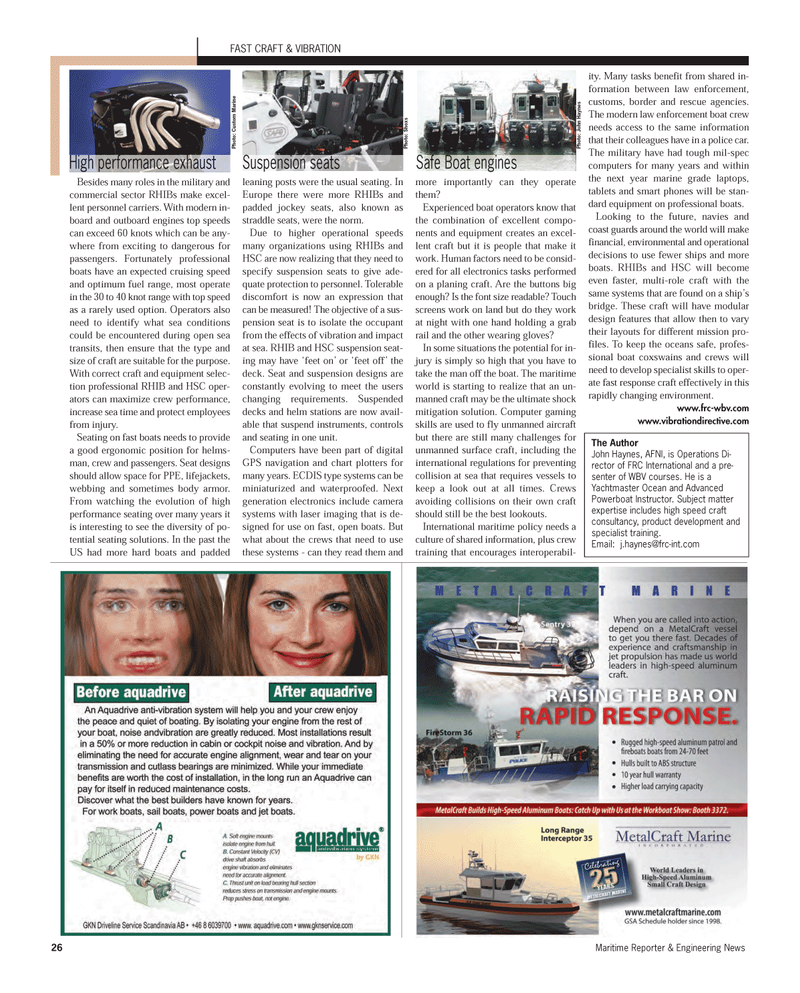
Page 26: of Maritime Reporter Magazine (November 2012)
Workboat Annual
Read this page in Pdf, Flash or Html5 edition of November 2012 Maritime Reporter Magazine
Besides many roles in the military and commercial sector RHIBs make excel- lent personnel carriers. With modern in- board and outboard engines top speedscan exceed 60 knots which can be any- where from exciting to dangerous for passengers. Fortunately professional boats have an expected cruising speed and optimum fuel range, most operatein the 30 to 40 knot range with top speedas a rarely used option. Operators alsoneed to identify what sea conditionscould be encountered during open seatransits, then ensure that the type andsize of craft are suitable for the purpose.With correct craft and equipment selec- tion professional RHIB and HSC oper- ators can maximize crew performance, increase sea time and protect employees from injury. Seating on fast boats needs to provide a good ergonomic position for helms- man, crew and passengers. Seat designs should allow space for PPE, lifejackets, webbing and sometimes body armor. From watching the evolution of high performance seating over many years it is interesting to see the diversity of po- tential seating solutions. In the past theUS had more hard boats and paddedleaning posts were the usual seating. InEurope there were more RHIBs andpadded jockey seats, also known as straddle seats, were the norm.Due to higher operational speedsmany organizations using RHIBs and HSC are now realizing that they need to specify suspension seats to give ade- quate protection to personnel. Tolerable discomfort is now an expression that can be measured! The objective of a sus- pension seat is to isolate the occupantfrom the effects of vibration and impact at sea. RHIB and HSC suspension seat-ing may have ?feet on? or ?feet off? the deck. Seat and suspension designs areconstantly evolving to meet the users changing requirements. Suspendeddecks and helm stations are now avail- able that suspend instruments, controlsand seating in one unit. Computers have been part of digital GPS navigation and chart plotters for many years. ECDIS type systems can be miniaturized and waterproofed. Next generation electronics include camerasystems with laser imaging that is de-signed for use on fast, open boats. But what about the crews that need to use these systems - can they read them and more importantly can they operate them?Experienced boat operators know that the combination of excellent compo- nents and equipment creates an excel- lent craft but it is people that make it work. Human factors need to be consid- ered for all electronics tasks performedon a planing craft. Are the buttons big enough? Is the font size readable? Touch screens work on land but do they work at night with one hand holding a grabrail and the other wearing gloves? In some situations the potential for in-jury is simply so high that you have to take the man off the boat. The maritime world is starting to realize that an un- manned craft may be the ultimate shockmitigation solution. Computer gaming skills are used to fly unmanned aircraftbut there are still many challenges for unmanned surface craft, including the international regulations for preventing collision at sea that requires vessels to keep a look out at all times. Crews avoiding collisions on their own craft should still be the best lookouts. International maritime policy needs a culture of shared information, plus crew training that encourages interoperabil- ity. Many tasks benefit from shared in- formation between law enforcement, customs, border and rescue agencies.The modern law enforcement boat crew needs access to the same informationthat their colleagues have in a police car. The military have had tough mil-spec computers for many years and within the next year marine grade laptops, tablets and smart phones will be stan-dard equipment on professional boats. Looking to the future, navies and coast guards around the world will make financial, environmental and operational decisions to use fewer ships and more boats. RHIBs and HSC will becomeeven faster, multi-role craft with the same systems that are found on a ship?s bridge. These craft will have modular design features that allow then to vary their layouts for different mission pro- files. To keep the oceans safe, profes- sional boat coxswains and crews will need to develop specialist skills to oper- ate fast response craft effectively in this rapidly changing environment. www.frc-wbv.com www.vibrationdirective.com FAST CRAFT & VIBRATION The AuthorJohn Haynes, AFNI, is Operations Di-rector of FRC International and a pre- senter of WBV courses. He is aYachtmaster Ocean and Advanced Powerboat Instructor. Subject matter expertise includes high speed craft consultancy, product development and specialist training.Email: [email protected] Photo: Custom MarinePhoto: ShoxsPhoto: John HaynesHigh performance exhaust Suspension seats Safe Boat engines26Maritime Reporter & Engineering News MR#11 (26-33):MR Template 11/7/2012 10:26 AM Page 26

 25
25

 27
27
